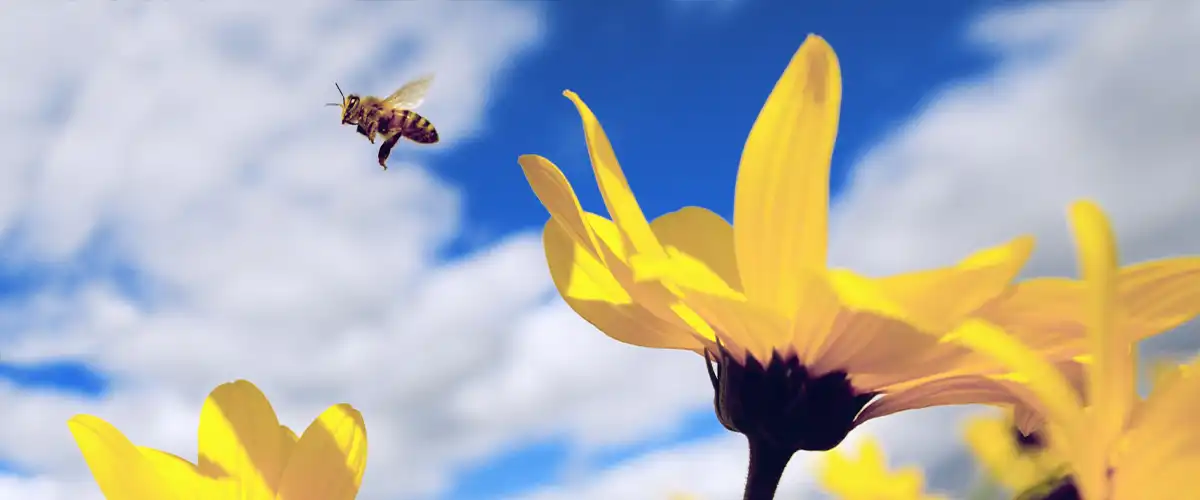This page may contain affiliate links.
Read our disclosure and privacy policy here.
Did you know that flowers can actually hear? It’s true! Scientists have discovered that flowers can sense the buzzing of bees using their petals. This amazing ability helps them know when bees are nearby, and they even react by making their nectar sweeter. Let’s dive into this fascinating discovery and learn how flowers listen to the world around them.
Table of Contents
Flowers Can Hear! Do They Understand Bee Buzz?
It All Started With A Hypothesis...
Every great discovery in science starts with a hypothesis, an idea that can be tested. Scientists wondered if flowers could sense the buzzing of bees. To find out, they formed a hypothesis: “Flowers can hear bees and will react to the buzzing of bees.” Testing this hypothesis was crucial to see if it was true. This process of forming a hypothesis and then testing it through experiments is how science progresses and helps us uncover new and exciting things about the world around us.
The Experiment (Testing The Hypothesis/Idea)
Designing the Experiment
To test the hypothesis, scientists needed a carefully designed experiment. They recorded the sounds of bees buzzing and played these recordings near evening primrose flowers. This setup allowed them to isolate the specific sound they wanted to test: the bee buzzing sound. By controlling which sounds the flowers were exposed to, and by and using by using the same recordings, they made sure that any changes in the flowers could only be coming as a result of the sound of bees.
Making Sure To Get Accurate Results
Scientists also needed to think about possible problems with the experiment, and how to solve them. Here are some of the problems they identified, and how they solved them.
Problem 1: Ensuring the Bee Buzzing Sound is Isolated
- Problem: How do we make sure the flower hears only the bee buzzing sound? If the flower hears different sounds, we wouldn’t know if it’s reacting to the bee buzzing or something else.
- Solution: Scientists created sound-proof barriers around the flowers so they could only hear the bee buzzing sound and no other noises.
- How This Helps: By isolating the bee buzzing sound, scientists ensured that any reaction from the flowers was due to the bee buzzing sound alone, making the experiment more accurate.
Problem 2: Ensuring the Flowers React to the Sound
- Problem: How do we know that the flower is actually reacting to the sound, and not to weather, soil quality, light, or anything else?
- Solution: Scientists created control groups. A control group is another set of flowers experiencing all the same conditions as the first set, with one exception: they didn’t play the bee buzzing sound for the control group.
- How This Helps: If the control group flowers react the same way as the flowers hearing the bee buzzing sound, then the sound isn’t causing the change. If only the flowers exposed to the buzzing sound produce sweeter nectar, scientists can be sure the sound is the key factor.
Problem 3: Determining If the Flower or Another Part of the Plant Senses the Buzzing
- Problem: How do we know if it’s the flower sensing the buzzing or some other part of the plant?
- Solution: Scientists used lasers to detect vibrations. They shined lasers on different parts of the plant and measured how each part moved when the bee buzzing sound was played. Sound is a mechanical wave, and produces vibrations in objects it comes in contact with. That’s actually how humans hear as well – sound travels into our ears, and causes our eardrum to vibrate. It is this vibration that we “hear” as sound.
- How This Helps: By using lasers, scientists could see that the petals were the part vibrating the most. Lasers used to detect vibrations are incredibly sensitive, so even the slightest vibrations can be detected. This showed that the petals were sensing the bee buzzing, not other parts of the plant.
Conclusion of the Experiment
Scientists discovered that flowers can hear the buzzing of bees using their petals. The petals of a flower are like their “ears”. When flowers sense these vibrations, they quickly make their nectar sweeter. This helps attract more bees, which in turn helps the flowers get pollinated and produce seeds. This means flowers are not just pretty to look at—they’re also smart and responsive. They can sense their environment and change to improve their chances of survival. Their survival depends on pollinators wanting to visit them and get nectar, so by making their nectar sweeter when bees are near, they increase the chances the bee will visit them, and pollinate them.
The scientists also tried to play different kinds of sounds to the flowers, and the flowers did not react, and did not make their nectar sweeter – this means that flowers are actually able to specifically recognize bees!
It’s really quite amazing how plants have evolved to be able to “hear” bees!
FAQ: 6 Questions Kids Ask The Most About A Flower's Ability To Hear Bees Buzzing
- How do we know that the flower made its nectar sweeter – did we taste it?
Scientists didn’t taste the nectar themselves. They used special instruments to measure the sugar levels in the nectar. When the flowers heard the bee buzzing, the sugar levels in their nectar increased, making it sweeter. Why do flowers want to attract bees?
Flowers want to attract bees because bees help with pollination. When bees visit flowers to collect nectar, they also carry pollen from one flower to another. This helps flowers produce seeds and grow new plants.- Can all flowers hear bees, or just some of them?
Not all flowers have been tested, but the study showed that at least some flowers, like the evening primrose, can hear bees. Scientists believe other flowers might have similar abilities, but more research is needed to find out. What did the lasers do in the experiment?
The lasers helped scientists see which parts of the flower were vibrating. They shined lasers on different parts of the plant and measured how each part moved when they played the bee buzzing sound. This showed that the petals were the ones sensing the sound.Do flowers react to other sounds, like music or people talking?
In this study, the flowers specifically reacted to the sound of bees. Scientists found that the flowers made sweeter nectar only when they heard the bee buzzing sound. It’s possible that flowers might react differently to other sounds, but this study focused on bee sounds.- Question: Why do flowers not always produce the sweetest nectar – why wait to hear a bee? Answer: Producing sweeter nectar requires more energy and resources from the plant. By waiting to hear a bee, the flower can save energy and only produce the sweetest nectar when there’s a higher chance of attracting pollinators. This strategy helps the flower be more efficient and conserve its resources.
References
The Wire Science Article: “Plants Know When a Bee Is Passing by and Produce Sweeter Nectar” – A detailed article on how flowers can sense and respond to bee buzzing. Read more
Tel Aviv University Study: Research by Tel Aviv University on plant-hearing and their response to bee sounds, which helped uncover the interaction between flowers and pollinators. Study details
University of Missouri Phytoacoustics Research: A study on how plants respond to vibrations, including defensive reactions to caterpillar munching. More about the research

There’s a lot to explore right where we are, in our own neighborhoods and backyards! Join us while we get off the couch and explore the everyday wonders of nature, science, space, engineering, art, and anything else we stumble upon during on our adventures.



